Dezhong Yao
NSPDI-SNN: An efficient lightweight SNN based on nonlinear synaptic pruning and dendritic integration
Aug 29, 2025Abstract:Spiking neural networks (SNNs) are artificial neural networks based on simulated biological neurons and have attracted much attention in recent artificial intelligence technology studies. The dendrites in biological neurons have efficient information processing ability and computational power; however, the neurons of SNNs rarely match the complex structure of the dendrites. Inspired by the nonlinear structure and highly sparse properties of neuronal dendrites, in this study, we propose an efficient, lightweight SNN method with nonlinear pruning and dendritic integration (NSPDI-SNN). In this method, we introduce nonlinear dendritic integration (NDI) to improve the representation of the spatiotemporal information of neurons. We implement heterogeneous state transition ratios of dendritic spines and construct a new and flexible nonlinear synaptic pruning (NSP) method to achieve the high sparsity of SNN. We conducted systematic experiments on three benchmark datasets (DVS128 Gesture, CIFAR10-DVS, and CIFAR10) and extended the evaluation to two complex tasks (speech recognition and reinforcement learning-based maze navigation task). Across all tasks, NSPDI-SNN consistently achieved high sparsity with minimal performance degradation. In particular, our method achieved the best experimental results on all three event stream datasets. Further analysis showed that NSPDI significantly improved the efficiency of synaptic information transfer as sparsity increased. In conclusion, our results indicate that the complex structure and nonlinear computation of neuronal dendrites provide a promising approach for developing efficient SNN methods.
ST-FlowNet: An Efficient Spiking Neural Network for Event-Based Optical Flow Estimation
Mar 13, 2025Abstract:Spiking Neural Networks (SNNs) have emerged as a promising tool for event-based optical flow estimation tasks due to their ability to leverage spatio-temporal information and low-power capabilities. However, the performance of SNN models is often constrained, limiting their application in real-world scenarios. In this work, we address this gap by proposing a novel neural network architecture, ST-FlowNet, specifically tailored for optical flow estimation from event-based data. The ST-FlowNet architecture integrates ConvGRU modules to facilitate cross-modal feature augmentation and temporal alignment of the predicted optical flow, improving the network's ability to capture complex motion dynamics. Additionally, to overcome the challenges associated with training SNNs, we introduce a novel approach to derive SNN models from pre-trained artificial neural networks (ANNs) through ANN-to-SNN conversion or our proposed BISNN method. Notably, the BISNN method alleviates the complexities involved in biological parameter selection, further enhancing the robustness of SNNs in optical flow estimation tasks. Extensive evaluations on three benchmark event-based datasets demonstrate that the SNN-based ST-FlowNet model outperforms state-of-the-art methods, delivering superior performance in accurate optical flow estimation across a diverse range of dynamic visual scenes. Furthermore, the inherent energy efficiency of SNN models is highlighted, establishing a compelling advantage for their practical deployment. Overall, our work presents a novel framework for optical flow estimation using SNNs and event-based data, contributing to the advancement of neuromorphic vision applications.
FedMHO: Heterogeneous One-Shot Federated Learning Towards Resource-Constrained Edge Devices
Feb 12, 2025



Abstract:Federated Learning (FL) is increasingly adopted in edge computing scenarios, where a large number of heterogeneous clients operate under constrained or sufficient resources. The iterative training process in conventional FL introduces significant computation and communication overhead, which is unfriendly for resource-constrained edge devices. One-shot FL has emerged as a promising approach to mitigate communication overhead, and model-heterogeneous FL solves the problem of diverse computing resources across clients. However, existing methods face challenges in effectively managing model-heterogeneous one-shot FL, often leading to unsatisfactory global model performance or reliance on auxiliary datasets. To address these challenges, we propose a novel FL framework named FedMHO, which leverages deep classification models on resource-sufficient clients and lightweight generative models on resource-constrained devices. On the server side, FedMHO involves a two-stage process that includes data generation and knowledge fusion. Furthermore, we introduce FedMHO-MD and FedMHO-SD to mitigate the knowledge-forgetting problem during the knowledge fusion stage, and an unsupervised data optimization solution to improve the quality of synthetic samples. Comprehensive experiments demonstrate the effectiveness of our methods, as they outperform state-of-the-art baselines in various experimental setups.
NumbOD: A Spatial-Frequency Fusion Attack Against Object Detectors
Dec 22, 2024Abstract:With the advancement of deep learning, object detectors (ODs) with various architectures have achieved significant success in complex scenarios like autonomous driving. Previous adversarial attacks against ODs have been focused on designing customized attacks targeting their specific structures (e.g., NMS and RPN), yielding some results but simultaneously constraining their scalability. Moreover, most efforts against ODs stem from image-level attacks originally designed for classification tasks, resulting in redundant computations and disturbances in object-irrelevant areas (e.g., background). Consequently, how to design a model-agnostic efficient attack to comprehensively evaluate the vulnerabilities of ODs remains challenging and unresolved. In this paper, we propose NumbOD, a brand-new spatial-frequency fusion attack against various ODs, aimed at disrupting object detection within images. We directly leverage the features output by the OD without relying on its internal structures to craft adversarial examples. Specifically, we first design a dual-track attack target selection strategy to select high-quality bounding boxes from OD outputs for targeting. Subsequently, we employ directional perturbations to shift and compress predicted boxes and change classification results to deceive ODs. Additionally, we focus on manipulating the high-frequency components of images to confuse ODs' attention on critical objects, thereby enhancing the attack efficiency. Our extensive experiments on nine ODs and two datasets show that NumbOD achieves powerful attack performance and high stealthiness.
DarkSAM: Fooling Segment Anything Model to Segment Nothing
Sep 26, 2024

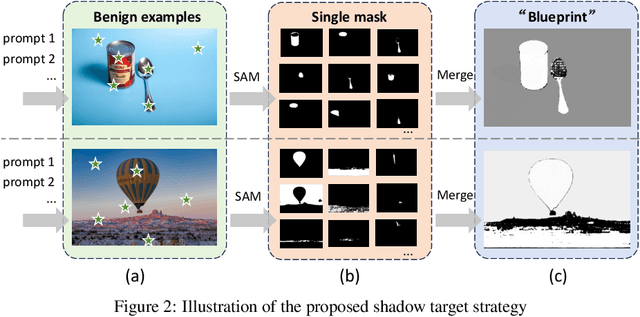

Abstract:Segment Anything Model (SAM) has recently gained much attention for its outstanding generalization to unseen data and tasks. Despite its promising prospect, the vulnerabilities of SAM, especially to universal adversarial perturbation (UAP) have not been thoroughly investigated yet. In this paper, we propose DarkSAM, the first prompt-free universal attack framework against SAM, including a semantic decoupling-based spatial attack and a texture distortion-based frequency attack. We first divide the output of SAM into foreground and background. Then, we design a shadow target strategy to obtain the semantic blueprint of the image as the attack target. DarkSAM is dedicated to fooling SAM by extracting and destroying crucial object features from images in both spatial and frequency domains. In the spatial domain, we disrupt the semantics of both the foreground and background in the image to confuse SAM. In the frequency domain, we further enhance the attack effectiveness by distorting the high-frequency components (i.e., texture information) of the image. Consequently, with a single UAP, DarkSAM renders SAM incapable of segmenting objects across diverse images with varying prompts. Experimental results on four datasets for SAM and its two variant models demonstrate the powerful attack capability and transferability of DarkSAM.
Reliable Object Tracking by Multimodal Hybrid Feature Extraction and Transformer-Based Fusion
May 28, 2024



Abstract:Visual object tracking, which is primarily based on visible light image sequences, encounters numerous challenges in complicated scenarios, such as low light conditions, high dynamic ranges, and background clutter. To address these challenges, incorporating the advantages of multiple visual modalities is a promising solution for achieving reliable object tracking. However, the existing approaches usually integrate multimodal inputs through adaptive local feature interactions, which cannot leverage the full potential of visual cues, thus resulting in insufficient feature modeling. In this study, we propose a novel multimodal hybrid tracker (MMHT) that utilizes frame-event-based data for reliable single object tracking. The MMHT model employs a hybrid backbone consisting of an artificial neural network (ANN) and a spiking neural network (SNN) to extract dominant features from different visual modalities and then uses a unified encoder to align the features across different domains. Moreover, we propose an enhanced transformer-based module to fuse multimodal features using attention mechanisms. With these methods, the MMHT model can effectively construct a multiscale and multidimensional visual feature space and achieve discriminative feature modeling. Extensive experiments demonstrate that the MMHT model exhibits competitive performance in comparison with that of other state-of-the-art methods. Overall, our results highlight the effectiveness of the MMHT model in terms of addressing the challenges faced in visual object tracking tasks.
Variational Bayes for Federated Continual Learning
May 23, 2024



Abstract:Federated continual learning (FCL) has received increasing attention due to its potential in handling real-world streaming data, characterized by evolving data distributions and varying client classes over time. The constraints of storage limitations and privacy concerns confine local models to exclusively access the present data within each learning cycle. Consequently, this restriction induces performance degradation in model training on previous data, termed "catastrophic forgetting". However, existing FCL approaches need to identify or know changes in data distribution, which is difficult in the real world. To release these limitations, this paper directs attention to a broader continuous framework. Within this framework, we introduce Federated Bayesian Neural Network (FedBNN), a versatile and efficacious framework employing a variational Bayesian neural network across all clients. Our method continually integrates knowledge from local and historical data distributions into a single model, adeptly learning from new data distributions while retaining performance on historical distributions. We rigorously evaluate FedBNN's performance against prevalent methods in federated learning and continual learning using various metrics. Experimental analyses across diverse datasets demonstrate that FedBNN achieves state-of-the-art results in mitigating forgetting.
Securely Fine-tuning Pre-trained Encoders Against Adversarial Examples
Mar 19, 2024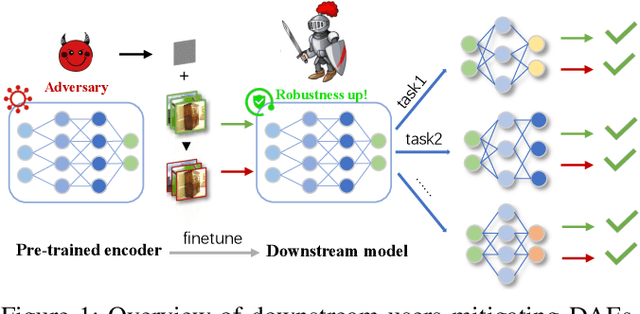

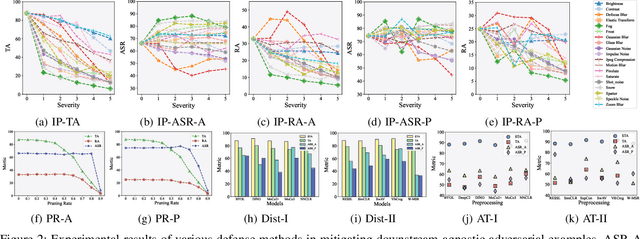

Abstract:With the evolution of self-supervised learning, the pre-training paradigm has emerged as a predominant solution within the deep learning landscape. Model providers furnish pre-trained encoders designed to function as versatile feature extractors, enabling downstream users to harness the benefits of expansive models with minimal effort through fine-tuning. Nevertheless, recent works have exposed a vulnerability in pre-trained encoders, highlighting their susceptibility to downstream-agnostic adversarial examples (DAEs) meticulously crafted by attackers. The lingering question pertains to the feasibility of fortifying the robustness of downstream models against DAEs, particularly in scenarios where the pre-trained encoders are publicly accessible to the attackers. In this paper, we initially delve into existing defensive mechanisms against adversarial examples within the pre-training paradigm. Our findings reveal that the failure of current defenses stems from the domain shift between pre-training data and downstream tasks, as well as the sensitivity of encoder parameters. In response to these challenges, we propose Genetic Evolution-Nurtured Adversarial Fine-tuning (Gen-AF), a two-stage adversarial fine-tuning approach aimed at enhancing the robustness of downstream models. Our extensive experiments, conducted across ten self-supervised training methods and six datasets, demonstrate that Gen-AF attains high testing accuracy and robust testing accuracy against state-of-the-art DAEs.
Revisiting Gradient Pruning: A Dual Realization for Defending against Gradient Attacks
Jan 30, 2024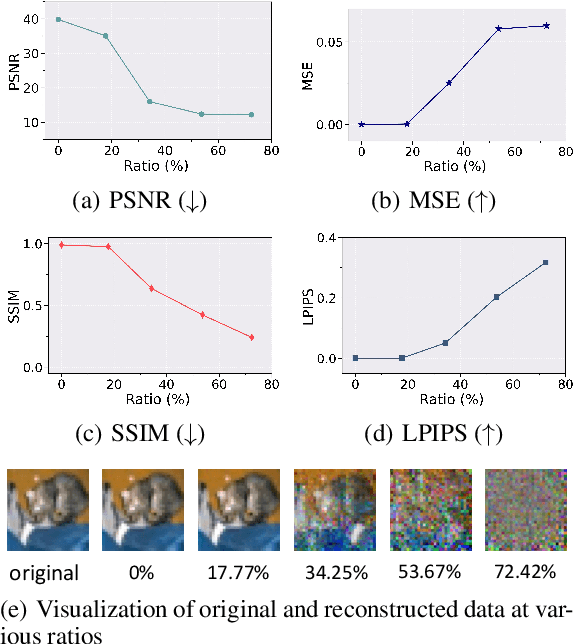
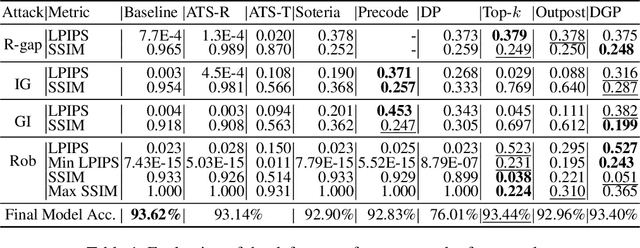
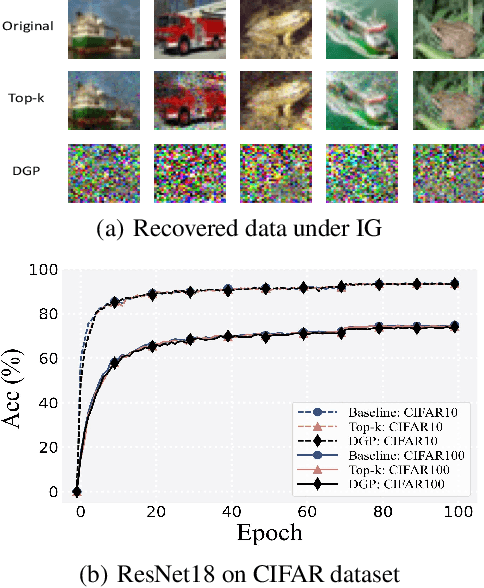

Abstract:Collaborative learning (CL) is a distributed learning framework that aims to protect user privacy by allowing users to jointly train a model by sharing their gradient updates only. However, gradient inversion attacks (GIAs), which recover users' training data from shared gradients, impose severe privacy threats to CL. Existing defense methods adopt different techniques, e.g., differential privacy, cryptography, and perturbation defenses, to defend against the GIAs. Nevertheless, all current defense methods suffer from a poor trade-off between privacy, utility, and efficiency. To mitigate the weaknesses of existing solutions, we propose a novel defense method, Dual Gradient Pruning (DGP), based on gradient pruning, which can improve communication efficiency while preserving the utility and privacy of CL. Specifically, DGP slightly changes gradient pruning with a stronger privacy guarantee. And DGP can also significantly improve communication efficiency with a theoretical analysis of its convergence and generalization. Our extensive experiments show that DGP can effectively defend against the most powerful GIAs and reduce the communication cost without sacrificing the model's utility.
FedRKG: A Privacy-preserving Federated Recommendation Framework via Knowledge Graph Enhancement
Jan 20, 2024Abstract:Federated Learning (FL) has emerged as a promising approach for preserving data privacy in recommendation systems by training models locally. Recently, Graph Neural Networks (GNN) have gained popularity in recommendation tasks due to their ability to capture high-order interactions between users and items. However, privacy concerns prevent the global sharing of the entire user-item graph. To address this limitation, some methods create pseudo-interacted items or users in the graph to compensate for missing information for each client. Unfortunately, these methods introduce random noise and raise privacy concerns. In this paper, we propose FedRKG, a novel federated recommendation system, where a global knowledge graph (KG) is constructed and maintained on the server using publicly available item information, enabling higher-order user-item interactions. On the client side, a relation-aware GNN model leverages diverse KG relationships. To protect local interaction items and obscure gradients, we employ pseudo-labeling and Local Differential Privacy (LDP). Extensive experiments conducted on three real-world datasets demonstrate the competitive performance of our approach compared to centralized algorithms while ensuring privacy preservation. Moreover, FedRKG achieves an average accuracy improvement of 4% compared to existing federated learning baselines.
 Add to Chrome
Add to Chrome Add to Firefox
Add to Firefox Add to Edge
Add to Edge